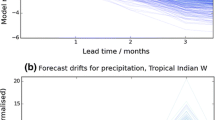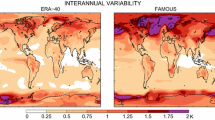Abstract
Large ensembles of coupled atmosphere–ocean general circulation model (AOGCM) simulations are required to explore modelling uncertainty and make probabilistic predictions of future transient climate change at regional scales. These are not yet computationally feasible so we have developed a technique to emulate the response of such an ensemble by scaling equilibrium patterns of climate change derived from much cheaper “slab” model ensembles in which the atmospheric component of an AOGCM is coupled to a mixed-layer ocean. Climate feedback parameters are diagnosed for each member of a slab model ensemble and used to drive an energy balance model (EBM) to predict the time-dependent response of global surface temperature expected for different combinations of uncertain AOGCM parameters affecting atmospheric, land and sea-ice processes. The EBM projections are then used to scale normalised patterns of change derived for each slab member, and hence emulate the response of the relevant atmospheric model version when coupled to a dynamic ocean, in response to a 1% per annum increase in CO2. The emulated responses are validated by comparison with predictions from a 17 member ensemble of AOGCM simulations, constructed from variants of HadCM3 using the same parameter combinations as 17 members of the slab model ensemble. Cross-validation permits estimation of the spatial and temporal dependence of emulation error, and also allows estimation of a correction field to correct discrepancies between the scaled equilibrium patterns and the transient response, reducing the emulation error. Emulated transient responses and their associated errors are obtained from the slab ensemble for 129 pseudo-HadCM3 versions containing multiple atmospheric parameter perturbations. These are combined to produce regional frequency distributions for the transient response of annual surface temperature change and boreal winter precipitation change. The technique can be extended to any surface climate variable demonstrating a scaleable, approximately linear response to forcing.


















Similar content being viewed by others
References
Annan JD, Hargreaves JC, Ohgaito R, Abe-Ouchi A, Emori S (2005) Efficiently constraining climate sensitivity with paleoclimate simulations. SOLA 1:181–184, http://www.jstage.jst.go.jp/browse/sola
Collins M, Booth BBB, Harris GR, Murphy JM, Sexton DMH, Webb MJ (2006) Towards quantifying uncertainty in transient climate change. Clim Dynam (in press). DOI 10.1007/s00382-006-0121-0
Cubasch U, Meehl GA, Boer GJ, Stouffer RJ, Dix M, Noda A, Senior CA, Raper S, Yap KS (2001) Projections of future climate change, In: Houghton JT, Ding Y, Griggs DJ, Noguer M, van der Linden PJ, Dai X, Maskell K, Johnson CA (eds) Climate change 2001: the scientific basis. Contribution of Working Group 1 to the 3rd assessment report of the IPCC, pp 525–582, Cambridge University Press, Cambridge, pp 881
Currin C, Mitchell TJ, Morris M, Ylvisaker D (1991) Bayesian prediction of deterministic functions, with application to the design and analysis of computer experiments. J Am Stat Assoc 86:953–963
Furrer R, Sain SR, Nychka D, Meehl GA (2006) Multivariate Bayesian analysis of atmosphere–ocean general circulation models. Environ Ecol Stat (in press)
Giorgi F, Francisco R (2000a) Uncertainties in regional climate change predictions. A regional analysis of ensemble simulations with the HadCM2 GCM. Clim Dynam 16:169–182
Giorgi F, Francisco R (2000b) Evaluating uncertainties in prediction of regional climate change. Geophys Res Lett 27:1295–1298
Good P, Lowe J (2006) Emergent behaviour and uncertainty in multi-model climate projections of precipitation trends at small spatial scales. J Clim (in press)
Gordon C, Cooper CA, Senior CA, Banks H, Gregory JM, Johns TC, Mitchell JFB, Wood RA (2000) The simulation of SST, sea ice extents and ocean heat transports in a version of the Hadley Centre coupled model without flux adjustments. Clim Dynam 16:147–168
Hoffert MI, Callegari AJ, Hsieh CT (1980) The role of deep sea heat storage in the secular response to climatic forcing. J Geophys Res 85:6667–6679
Huntingford C, Cox PM (2000) An analogue model to derive additional climate change scenarios from existing GCM simulations. Clim Dynam 16:575–586
Johns TC, Gregory JM, Ingram WJ, Johnson CE, Jones A, Lowe JA, Mitchell JFB, Roberts DL, Sexton DMH, Stevenson DS, Tett SFB, Woodage MJ (2003) Anthropogenic climate change for 1860 to 2100 simulated with the HadCM3 model under updated emissions scenarios. Clim Dynam 20:583–612
Mitchell T (2003) Pattern scaling. Climatic Change 60:217–242
Mitchell JFB, Johns TC, Eagles M, Ingram WJ, Davis RA (1999) Towards the construction of climate change scenarios. Climatic Change 41:547–581
Murphy JM (1995) Transient response of the Hadley Centre coupled ocean-atmosphere model to increasing carbon dioxide. Part III: analysis of global-mean response using simple models. J Climate 8:496–514
Murphy JM, Sexton DMH, Barnett DN, Jones GS, Webb MJ, Collins M, Stainforth DJ (2004) Quantification of modelling uncertainties in a large ensemble of climate change simulations. Nature 430:768–772
Nakicenovic NJ Alcamo J, Davis G, de Vries B, Fenham J, Gaffin S, Gregory K, Grübler A, Jung TY, Kram T La Rovere EL, Michaelis L, Mori S, Morita T, Pepper W, Pitcher H, Price L, Raihi K, Roehrl A, Rogner H-H, Sankovski A, Schlesinger M, Shukla P, Smith S, Swart R, van Rooijen S, Victor N, Dadi Z, (2000) Emissions scenarios. A special report of working group III of the intergovernmental panel on climate change. Cambridge University Press, Cambridge, pp 599
Pittock AB, Jones RN, Mitchell CD (2001) Probabilities will help us plan for climate change. Nature 413:249–249
Pope VD, Gallani ML, Rowntree PR, Stratton RA (2000) The impact of new physical parameterizations in the Hadley Centre climate model: HadAM3. Clim Dynam 16:123–146
Press WH, Teukolsky SA, Vetterling WT, Flannery BP (1992) Numerical recipes in Fortran 77: the art of scientific computing, vol 1. Cambridge University Press, Cambridge, pp 402
Raper SCB, Gregory JM, Osborn TJ (2001) Use of an upwelling-diffusion energy balance climate model to simulate and diagnose A/OGCM results. Clim Dynam 17:601–613
Santer BD, Wigley TML, Schlesinger ME, Mitchell JFB (1990) Developing climate scenarios from equilibrium GCM results. Max-Planck Institute for Meteorology Report Number 47, Hamburg
Schlesinger ME, Andronova NG, Entwistle B, Ghanem A, Ramankutty N, Wang W, Yang F (1997) Modelling and simulation of climate and climate change. In: Catagnoli GC, Provenzale A (eds) Past and present variability of the solar-terrestrial system. International School of Physics Enrico Fermi, vol 133. IOS Press, Amsterdam pp 389–429
Shine K, Derwent R, Wuebbles D, Morcette JJ (1990) Radiative forcing of climate. In: Houghton J, Jenkins G, Ephraums J (eds) Climate change. The IPCC scientific assessment. Cambridge University Press, Cambridge, pp 45–68
Stainforth DA, Aina T, Christensen C, Collins M, Faull N, Frame DJ, Kettleborough JA, Knight S, Martin A, Murphy JM, Piani C, Sexton DMH, Smith LA, Spicer RA, Thorpe AJ, Allen MR (2005) Uncertainty in predictions of the climate response to rising levels of greenhouse gases. Nature 433:403–406
Tebaldi C, Smith RL, Nychka D, Mearns LO (2005) Quantifying uncertainty in projections of regional climate change: a Bayesian approach to the analysis of multi-model ensembles. J Climate 18:1524–1540
Webb MJ, Senior CA, Sexton DMH, Ingram WJ, Williams KD, Ringer MA, McAvaney BJ, Colman R, Soden BJ, Gudgel R, Knutson T, Emori S, Ogura T, Tsushima Y, Andronova N, Li B, Musat I, Bony S, TAylor KE (2006) On the contribution of local feedback mechanisms to the range of climate sensitivity in two GCM ensembles. Clim Dynam (in press). DOI 10.1007/s000382-006-0111-2
Williams KD, Senior CA, Mitchell JFB (2001) Transient climate change in the Hadley Centre models: the role of physical processes. J Climate 14:2659–2674
Acknowledgments
This work could not have been possible without input from many dedicated Hadley Centre staff. The work was supported by the UK Department for Environment, Food and Rural Affairs under Contract PECD/7/12/37 and by the European Community ENSEMBLES project (GOCE-CT-2003–505539) under the Sixth Framework Programme.
Author information
Authors and Affiliations
Corresponding author
Appendix
Appendix
This section provides an estimate of the variance in the frequency distribution of the transient regional response emulated from the slab ensemble. For a given region and time, the emulated response P j in Eq. 10 is assumed to be equivalent to:
where s j is the signal in the combined slab and correction field pattern for member j, and ɛj is random internal variability in the normalised slab pattern uncorrelated with s j . Internal variability in the slab pattern arises since we have used 20 year means to estimate the response. The variance of the emulated frequency distribution is:
where to each emulated response P j we add random noise δ j , sampled from a normal distribution with some yet to be determined variance δ2. In the limit (N−1)/N →1, and with \(\overline{{\delta _{j} }} = 0\) this becomes
Equation 14 for P j is used in Eq. 16 to give
Random internal variability in the slab pattern is assumed to be uncorrelated with EBM projections for ΔT, so the last three terms in Eq. 17 equal zero. Defining the variance Vs in scaled prediction of the true slab pattern signal:
the variance in the emulated frequency distribution becomes
The second term in Eq. 19, with internal variability scaled by the EBM global temperature response ΔT 2, represents variance due to our uncertain knowledge of the true slab signal. The remaining variance \(\overline{{\delta ^{2} }} \) will include a contribution V em arising from uncertainty in the emulation, and variance \(\overline{{\eta ^{2} }} \) due to random internal variability in the transient response being emulated:
The variance δ2 can be estimated from the cross validation ensemble. Similarly to Eq. 14, we assume the AOGCM simulated response M j for a given region and time is equal to a model signal m j , plus random internal variability η j uncorrelated with m j :
Substituting e j =P j −M j into the definition for σ2 in Eq. 8, expanding, and setting the means of uncorrelated terms such as \(\overline{{s\eta }} \) to zero, the variance in cross validation error is given by
The first term in Eq. 22 is the variance of the emulation error for the true signal, which we identify as V em, i.e.:
V em includes error due to non-linearities in the simulated AOGCM signal m j , and error due to discrepancy between m j and the slab signal scaled by global temperature from the EBM. The second term in Eq. 22 represents uncertainty in the validation due to random internal variability in the AOGCM transient simulations. The third term represents emulation uncertainty due to scaling of random internal variability in the slab patterns by the temperature response. A quadratic dependence on ΔT is indeed demonstrated in Fig. 9, where the variance in emulation error σ2 for Northern Europe surface temperature is shown (blue curve).
Equation 22 can be rewritten:
and combining this with Eq. 20, we arrive at an expression that relates δ2 to the variance of cross validation error:
assuming ɛ j to be uncorrelated with ΔT j . The required variance in random uncertainty associated with each emulation P j is therefore equal to the variance in cross validation error, minus the variance associated with scaling of random internal variability in the slab patterns by the global temperature response. An estimate for \(\overline{{\varepsilon ^{2} }} \) is obtained from thirty 20 year means from a 600 year control simulation with the HadSM3 standard slab model configuration.
Rights and permissions
About this article
Cite this article
Harris, G.R., Sexton, D.M.H., Booth, B.B.B. et al. Frequency distributions of transient regional climate change from perturbed physics ensembles of general circulation model simulations. Clim Dyn 27, 357–375 (2006). https://doi.org/10.1007/s00382-006-0142-8
Received:
Accepted:
Published:
Issue Date:
DOI: https://doi.org/10.1007/s00382-006-0142-8




